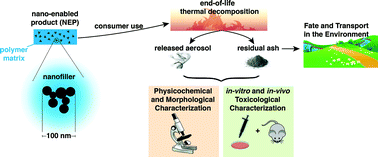An integrated methodology for the assessment of environmental health implications during thermal decomposition of nano-enabled products†
Abstract
The proliferation of nano-enabled products (NEPs) renders human exposure to engineered nanomaterials (ENMs) inevitable. Over the last decade, the risk assessment paradigm for nanomaterials focused primarily on potential adverse effect of pristine, as-prepared ENMs. However, the physicochemical properties of ENMs may be drastically altered across their life-cycle (LC), especially when they are embedded in various NEP matrices. Of a particular interest is the end-of-life scenario by thermal decomposition. The main objective of the current study is to develop a standardized, versatile and reproducible methodology that allows for the systematic physicochemical and toxicological characterization of the NEP thermal decomposition. The developed methodology was tested for an industry-relevant NEP in order to verify its versatility for such LC investigations. Results are indicative of potential environmental health risks associated with waste from specific NEP families and prompt for the development of safer-by-design approaches and exposure control strategies.

- This article is part of the themed collection: Sustainable Nanotechnology Organization 2014

 Please wait while we load your content...
Please wait while we load your content...